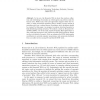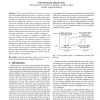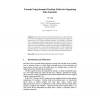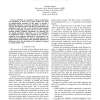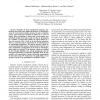101
Voted
SEMWEB
2010
Springer
14 years 9 months ago
2010
Springer
Abstract. In its core, the Semantic Web is about the creation, collection and interlinking of metadata on which agents can perform tasks for human users. While many tools and appro...
92
Voted
PDPTA
2010
14 years 9 months ago
2010
Abstract-- The success of Web Services as a tool to decouple and distribute different processes is beyond any doubt. On the one hand, their distributed nature makes them perfect to...
OTM
2010
Springer
14 years 9 months ago
2010
Springer
In the ITEA2 Do-It-Yourself Smart Experiences project (DIY-SE), we are required to design an ontology-based ambient computing environment to support users to DIY their personalized...
86
Voted
ICWS
2010
IEEE
14 years 9 months ago
2010
IEEE
WS-Policy is a standard to express requirements and capabilities in Web service systems. Policies are based on domain-specific assertions. In this paper we present a lightweight ap...
ICDE
2010
IEEE
14 years 9 months ago
2010
IEEE
Abstract-- Classification hierarchies are trees where links codify the fact that a node lower in the hierarchy contains documents whose contents are more specific than those one le...
115
Voted
BMVC
2010
14 years 9 months ago
2010
In this paper we propose a novel approach to introducing semantic relations into the bag-of-words framework. We use the latent semantic models, such as LSA and pLSA, in order to d...
ACSD
2010
IEEE
14 years 9 months ago
2010
IEEE
Abstract--Semantics of many specification languages, particularly those used in the domain of hardware, is described in terms of vector-based transition systems. In such a transiti...
ACL
2010
14 years 9 months ago
2010
This paper explores joint syntactic and semantic parsing of Chinese to further improve the performance of both syntactic and semantic parsing, in particular the performance of sem...
89
Voted
ACL
2010
14 years 9 months ago
2010
This research explores the idea of inducing domain-specific semantic class taggers using only a domain-specific text collection and seed words. The learning process begins by indu...
ACL
2010
14 years 9 months ago
2010
We argue that groups of unannotated texts with overlapping and non-contradictory semantics represent a valuable source of information for learning semantic representations. A simp...
